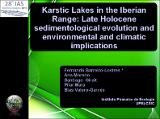Por favor, use este identificador para citar o enlazar a este item:
http://hdl.handle.net/10261/102881COMPARTIR / EXPORTAR:
 SHARE
BASE SHARE
BASE
|
|
| Visualizar otros formatos: MARC | Dublin Core | RDF | ORE | MODS | METS | DIDL | DATACITE | |

| Título: | Karstic Lakes in the Iberian Range: Late Holocene sedimentological evolution and environmental and climatic implications |
Autor: | Barreiro-Lostres, Fernando CSIC ORCID ; Moreno Caballud, Ana CSIC ORCID ; Giralt, Santiago CSIC ORCID ; Mata Campo, Maria Pilar; Valero-Garcés, Blas L. CSIC ORCID | Fecha de publicación: | 3-oct-2014 | Resumen: | Numerous karstic lakes in the Iberian Range were originated during an Upper Pliocene-Pleistocene karstification phase affecting Mesozoic limestone formations. This led to the formation of large karstic lakes developed by sinkhole coalescence and tufa growth. The regional climate of this area is Mediterranean and the hydrology is mostly controlled by groundwaters, with limited surface runoff. In order to reconstruct paleoenvironmental variations during Late Holocene, the sedimentary sequences of three lakes in Guadalajara and Cuenca province have been analyzed using a multiproxy strategy. These lake basins contain thick carbonaterich, laminated sedimentary sequences. All these lake deposits present complex lateral and vertical facies changes illustrating the interaction of depositional, biological and hydrochemical factors. Core sections were split longitudinally, imaged, and the sedimentary facies were identified and described including microscopic studies. Geochemical composition was obtained with an X-Ray Fluorescence scanner. Chronology is constrained by 210Pb, 137Cs and 14C AMS dates. The Laguna de Taravilla (40°39´N, 1°59´W, 1100 m a.s.l.) is a small lake located behind a tufa dam in the Tajo River. Sedimentation is dominated by clastic input from an ephemeral creek. The 6 m long retrieved sedimentary sequence covers the last 2000 years. El Tobar (40º32´N; 3º56´W, 1200 m a.s.l.; 20 m depth) is the largest lake on the region, with a monomictic and a meromictic sub-basins. We obtained six long cores (up to 7.8 m long) and a number of short cores. A basal AMS date in one of the long cores is 2050 ± 30 14C yr BP and preliminary 210Pb dating confirms a very high sedimentation rate. The sequence is finely laminated, with intervals composed of organic and clastic couplets. The Laguna de la Parra (39° 58´N, 1° 52´W, 1000 m a.s.l.; 116 m of diameter and 17.5 m depth) belongs to the Cañada del Hoyo lake complex. The doline in which the lake is developed originated in dolomites that overlie impermeable Middle-Upper-Cenomanian green clay-marls. Two long sediment cores (up to 6.92 m long) and four short cores were recovered from the deepest part of the lake. The preliminary chronological model based on nine 14C AMS dates shows that lacustrine deposition started about 1500 years ago. We investigate, with a multidisciplinary approach, the relationships of facies distribution and lake level fluctuations through the analyses of three main processes affecting the sedimentary infill: clastic input, endogenic mineral formation and meromictic conditions. The three sequences show a coherent scenario of lower lake levels during early medieval times and increased lake levels during the Little Ice Age. These karstic lacustrine sequences contain an important amount of environmental information that can be used to reconstruct the hydrological and geochemical evolution of rapid-response lacustrine systems to anthropogenic and climate forcing during the last 2000 years. | Descripción: | 31 páginas.- Presentación realizada para el 28th IAS Meeting of Sedimentology, 5—8 Julio 2011, Zaragoza. | URI: | http://hdl.handle.net/10261/102881 |
| Aparece en las colecciones: | (IPE) Comunicaciones congresos (IGME) Comunicaciones congresos |
Ficheros en este ítem:
| Fichero | Descripción | Tamaño | Formato | |
|---|---|---|---|---|
| IAS_Karstic_Lakes_final.pdf | 3,12 MB | Adobe PDF |  Visualizar/Abrir |
CORE Recommender
Page view(s)
388
checked on 19-abr-2024
Download(s)
170
checked on 19-abr-2024
Google ScholarTM
Check
NOTA: Los ítems de Digital.CSIC están protegidos por copyright, con todos los derechos reservados, a menos que se indique lo contrario.
